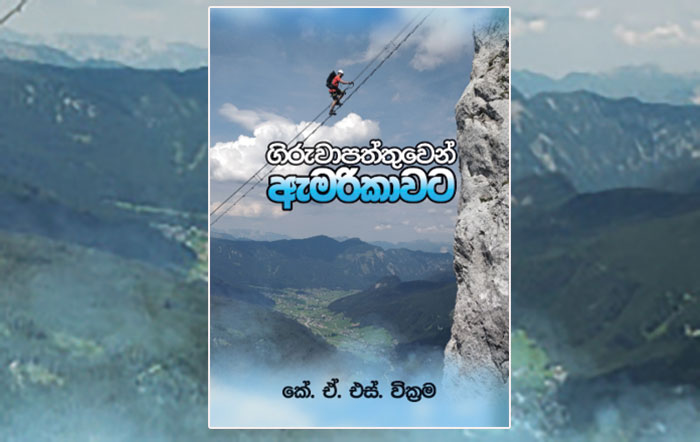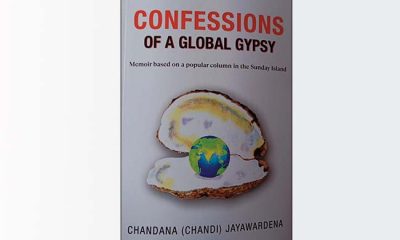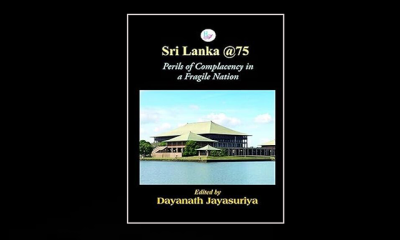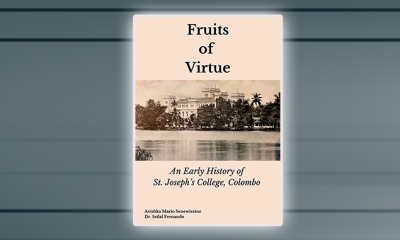Features
Giruwa-Pattuwen Amerikawata (To the US from Giruvapattuwa)

Book Review
by Prof. Agalakada Sirisumana Thero
Sinhala Studies Department
University of Colombo.
The narrative tracing the journey from Giruvapattuwa to the USA unfolds as a compelling tale, chronicling the experiences of the first-class civil servant, Professor KAS Wickrama.
It embedded within the rich tapestry of Sri Lankan literature, where certain autobiographies stand as distinctive pillars. Amidst this literary landscape, Anagarika Dharmapala’s diaries, Professor Sarachchandra’s Pin Athi Sarasavi Waramak Denne, Martin Wickramasinghe’s Upanda Sita, and Kumarathunga Munidasa’s Piyasamara carve out individual niches. These literary works not only contribute to the literary heritage of Sri Lanka but also offer glimpses into the diverse experiences of their authors.
Beyond the realm of creative expressions, government officials have also left unforgettable marks by documenting their intriguing journeys in administration. Leel Gunasekara’s noteworthy work, Athsan and Pethsam, holds a significant place in this genre, shedding light on his professional odyssey while serving as the government agent in Rajarata.
Within this literary surroundings, Wickrama’s journey unfolds as a captivating narrative, traversing the geographical and cultural landscapes from Giruvapattuwa to the United States. The nuanced storytelling captures the essence of his experiences, offering readers a window into the challenges, triumphs, and transformations that marked his life’s trajectory.
Embedded within this dynamic literary tradition, Wickrama’s narrative contributes depth to the variety of autobiographies, enhancing the cultural and literary heritage of Sri Lanka.
The book is incredibly engaging; once you start, it’s hard to put down. It becomes imperative for readers to articulate their thoughts about this literary work for several compelling reasons.
The book traces the life journey of someone born into an ordinary family in Matara. Starting as a teacher, the protagonist climbs the ranks in the Sri Lanka Administrative Service, eventually becoming a government agent. The story highlights the protagonist’s determined path, securing a fellowship that leads to postgraduate education in America. The culmination of this journey sees him earning a doctoral degree and ascending to the position of a university professor.
The book goes beyond just listing personal achievements; it stands as a testament to resilience in the face of significant challenges. It embodies the spirit of Uttana, depicting a nation marked by the courage to confront challenges rather than yielding to idleness. In this context, the book becomes essential reading for today’s Sri Lankan youth, inspiring them to face and conquer obstacles in their own lives.
The reader delving into this book can gain insights into the following aspects:
Understanding the societal order that influenced the lives of rural residents in the southern province of Sri Lanka during the mid-20th century.
Recognizing the robust education system established through Central Colleges (Madya Maha Vidyala) before the current diverse educational landscape in Sri Lanka.
Exploring the leftist political atmosphere that emerged in Sri Lanka post-independence, and the subsequent development of right-wing politics.
Examining the historical context of the 1971 People’s Liberation Front (JVP) rebellion and the social reforms that ensued from it.
Highlighting various facets of American university education and shedding light on socio-political information.
This information is crucial for understanding the rural life in the southern province of Sri Lanka during the mid-20th century. The Vesak Festival, illuminated by numerous artistic talents, serves as an introduction to modern mechanical life and a creative era. Matara , strongly influenced by Dr. SA Wickramasinghe, holds a significant place in leftist politics, as discussed by the author who provides a social scientist’s commentary on leftist political activity. Revealing a society that lived inspiringly and happily despite challenges, the author also addresses issues like harsh casteism and floods, offering a glimpse into the backdrop of the modern social environment.
In a time when education in Sri Lanka faced challenges, Thelijjavila Central College stood out by emphasizing science education, paving the way for its students to excel at Peradeniya University. This reflects the genuine intelligence nurtured at the school. Additionally, education across schools in Matara reached a commendable standard during the tenure of Education Minister Eriyagolla, this period evokes pride in a generation of farmers and students who contributed to the country’s prosperity, as reflected in the anthem “Sri Lanka is the greatest country in the world, and our homeland is Sri Lanka.” (Loken uthum rata lankavayi, apa nija bhumiya lankavayi).
The author also delves into the leftist political landscape shaped by Dr. Wickramasinghe, Colvin R de Silva, and N.M. Perera. The commentary sheds light on the initiation of leftist parties and their stance against Bandaranayake’s politics. The author explores how the political trajectory in Sri Lanka took a different turn after the murder of Bandaranayake.
The pivotal commentary at the beginning of this book revolves around the 1971 Janatha Vimukthi Peramuna rebellion and the concurrent era of development initiated by the government of Sirima Bandaranaike. As a deputy governor of Giruwapatthu, the author actively participated in the program, and his reflections highlight its impact on uplifting the lives of rural communities.
He recounts the experience of embarking on a challenging journey to pursue a doctoral degree at an American university. The narrative details the hardships he faced in adapting to an exceptionally tough life in America and the gradual adjustment to his career, serving as a powerful inspiration for contemporary scientists filled with great enthusiasm.
Having reached the zenith of success in life, the author underscores the profound influence of his accomplished wife as the driving force behind his development and progress. Additionally, he shares the decision to send their two children on a mission to Sri Lanka. Becoming an estate owner in Hinidumpattuwa, he eagerly anticipates the forthcoming season, embracing a life of joy.
His life story stands as a significant and inspiring guide for the younger generation navigating the shores of contemporary life.
Features
RuGoesWild: Taking science into the wild — and into the hearts of Sri Lankans

At a time when misinformation spreads so easily—especially online—there’s a need for scientists to step in and bring accurate, evidence-based knowledge to the public. This is exactly what Dr. Ruchira Somaweera is doing with RuGoesWild, a YouTube channel that brings the world of field biology to Sri Lankan audiences in Sinhala.
“One of my biggest motivations is to inspire the next generation,” says Dr. Somaweera. “I want young Sri Lankans to not only appreciate the amazing biodiversity we have here, but also to learn about how species are studied, protected, and understood in other parts of the world. By showing what’s happening elsewhere—from research in remote caves to marine conservation projects—I hope to broaden horizons and spark curiosity.”
Unlike many travel and wildlife channels that prioritise entertainment, RuGoesWild focuses on real science. “What sets RuGoesWild apart is its focus on wildlife field research, not tourism or sensationalised adventures,” he explains. “While many travel channels showcase nature in other parts of the world, few dig into the science behind it—and almost none do so in Sinhala. That’s the niche I aim to fill.”
Excerpts of the Interview
Q: Was there a specific moment or discovery in the field that deeply impacted you?
“There have been countless unforgettable moments in my 20-year career—catching my first King cobra, discovering deep-diving sea snakes, and many more,” Dr. Somaweera reflects. “But the most special moment was publishing a scientific paper with my 10-year-old son Rehan, making him one of the youngest authors of an international peer-reviewed paper. We discovered a unique interaction between octopi and some fish called ‘nuclear-forager following’. As both a dad and a scientist, that was an incredibly meaningful achievement.”

Saltwater crocodiles in Sundarbans in Bangladesh, the world’s largest mangrove
Q: Field biology often means long hours in challenging environments. What motivates you to keep going?
“Absolutely—field biology can be physically exhausting, mentally draining, and often dangerous,” he admits. “I’ve spent weeks working in some of the most remote parts of Australia where you can only access through a helicopter, and in the humid jungles of Borneo where insects are insane. But despite all that, what keeps me going is a deep sense of wonder and purpose. Some of the most rewarding moments come when you least expect them—a rare animal sighting, a new behavioural observation, or even just watching the sun rise over a pristine habitat.”
Q: How do you balance scientific rigour with making your work engaging and understandable?
“That balance is something I’m constantly navigating,” he says. “As a scientist, I’m trained to be precise and data-driven. But if we want the public to care about science, we have to make it accessible and relatable. I focus on the ‘why’ and ‘wow’—why something matters, and what makes it fascinating. Whether it’s a snake that glides between trees, a turtle that breathes through its backside, or a sea snake that hunts with a grouper, I try to bring out the quirky, mind-blowing parts that spark curiosity.”
Q: What are the biggest misconceptions about reptiles or field biology in Sri Lanka?
“One of the biggest misconceptions is that most reptiles—especially snakes—are dangerous and aggressive,” Dr. Somaweera explains. “In reality, the vast majority of snakes are non-venomous, and even the venomous ones won’t bite unless they feel threatened. Sadly, fear and myth often lead to unnecessary killing. With RuGoesWild, one of my goals is to change these perceptions—to show that reptiles are not monsters, but marvels of evolution.”
Q: What are the most pressing conservation issues in Sri Lanka today?
“Habitat loss is huge,” he emphasizes. “Natural areas are being cleared for housing, farming, and industry, which displaces wildlife. As people and animals get pushed into the same spaces, clashes happen—especially with elephants and monkeys. Pollution, overfishing, and invasive species also contribute to biodiversity loss.”

Manta Rays
Q: What role do local communities play in conservation, and how can scientists better collaborate with them?
“Local communities are absolutely vital,” he stresses. “They’re often the first to notice changes, and they carry traditional knowledge. Conservation only works when people feel involved and benefit from it. We need to move beyond lectures and surveys to real partnerships—sharing findings, involving locals in fieldwork, and even ensuring conservation makes economic sense to them through things like eco-tourism.”
Q: What’s missing in the way biology is taught in Sri Lanka?
“It’s still very exam-focused,” Dr. Somaweera says. “Students are taught to memorize facts rather than explore how the natural world works. We need to shift to real-world engagement. Imagine a student in Anuradhapura learning about ecosystems by observing a tank or a garden lizard, not just reading a diagram.”
Q: How important is it to communicate science in local languages?
“Hugely important,” he says. “Science in Sri Lanka often happens in English, which leaves many people out. But when I speak in Sinhala—whether in schools, villages, or online—the response is amazing. People connect, ask questions, and share their own observations. That’s why RuGoesWild is in Sinhala—it’s about making science belong to everyone.”

‘Crocodile work’ in northern Australia.
Q: What advice would you give to young Sri Lankans interested in field biology?
“Start now!” he urges. “You don’t need a degree to start observing nature. Volunteer, write, connect with mentors. And once you do pursue science professionally, remember that communication matters—get your work out there, build networks, and stay curious. Passion is what will carry you through the challenges.”
Q: Do you think YouTube and social media can shape public perception—or even influence policy?
“Absolutely,” he says. “These platforms give scientists a direct line to the public. When enough people care—about elephants, snakes, forests—that awareness builds momentum. Policymakers listen when the public demands change. Social media isn’t just outreach—it’s advocacy.”
by Ifham Nizam
Features
Benjy’s vision materalises … into Inner Vision

 Bassist Benjy Ranabahu is overjoyed as his version of having his own band (for the second time) is gradually taking shape.
Bassist Benjy Ranabahu is overjoyed as his version of having his own band (for the second time) is gradually taking shape.
When asked as to how the name Inner Vision cropped up, Benjy said that they were thinking of various names, and suggestions were made.
“Since we have a kind of a vision for music lovers, we decided to go with Inner Vision, and I guarantee that Inner Vision is going to be a band with a difference,” said Benjy.
In fact, he has already got a lineup, comprising musicians with years of experience in the music scene.
Benjy says he has now only to finalise the keyboardist, continue rehearsing, get their Inner Vision act together, and then boom into action.
“Various names have been suggested, where the keyboard section is concerned, and very soon we will pick the right guy to make our vision a reality.”
Inner Vision will line-up as follows…
Anton Fernando

Benjy Ranabahu:
Ready to give music
lovers a new vision
(Lead guitar/vocals): Having performed with several bands in the past, including The Gypsies, he has many years of experience and has also done the needful in Japan, Singapore, Dubai, the Maldives, Zambia, Korea, New Zealand, and the Middle East.
Lelum Ratnayake
(Drums/vocals): The son of the legendary Victor Ratnayake, Lelum has toured Italy, Norway, Japan, Australia, Zambia, Kuwait and Oman as a drummer and percussionist.
Viraj Cooray
(Guitar/vocals): Another musician with years of experience, having performed with several of our leading outfits. He says he is a musician with a boundless passion for creating unforgettable experiences, through music.
Nish Peiris

Nish Peiris: Extremely talented
(Female vocals): She began taking singing, seriously, nearly five years ago, when her mother, having heard her sing occasionally at home and loved her voice, got her involved in classes with Ayesha Sinhawansa. Her mom also made her join the Angel Chorus. “I had no idea I could sing until I joined Angle Chorus, which was the initial step in my career before I followed my passion.” Nish then joined Soul Sounds Academy, guided by Soundarie David. She is currently doing a degree in fashion marketing.
And … with Benjy Ranabahu at the helm, playing bass, Inner Vision is set to light up the entertainment scene – end May-early June, 2025.
Features
Can Sri Lanka’s premature deindustrialisation be reversed?

 As politicians and economists continue to proclaim that the Sri Lankan economy has achieved ‘stability’ since the 2022 economic crisis, the country’s manufacturing sector seems to have not got the memo.
As politicians and economists continue to proclaim that the Sri Lankan economy has achieved ‘stability’ since the 2022 economic crisis, the country’s manufacturing sector seems to have not got the memo.
A few salient points need to be made in this context.
First, Sri Lankan manufacturing output has been experiencing a secular stagnation that predates external shocks, such as the pandemic and the Easter Attacks. According to national accounts data from UNIDO, manufacturing output in dollar terms has basically flatlined since 2012. Without a manufacturing engine at its core, it is no surprise that Sri Lanka has seen some of the lowest rates of economic growth during this period. (See graph)
Second, factory capacity utilisation still remains below pre-pandemic levels. Total capacity utilisation stood at 62% in 2024, compared to 81% in 2019. For wearing apparel, the country’s main manufactured export, capacity utilisation was at a meagre 58% in 2024, compared to 83% in 2019. Given the uncertainty Trump’s tariffs have cast on global trade, combined with the diminished consumer sentiment across the Global North, it is hard to imagine capacity utilisation recovering to pre-pandemic levels in the near future.
Third, new investment in manufacturing has been muted. From 2019 to 2024, only 26% of realised foreign investments in Board of Investment enterprises were in manufacturing. This indicates that foreign capital does not view the country as a desirable location for manufacturing investment. It also reflects a global trend – according to UNCTAD, 81% of new foreign investment projects, between 2020 and 2023, were in services.
Taken together, these features paint an alarming picture of the state of Sri Lankan manufacturing and prospects for longer-term growth.
What makes manufacturing so special?
A critical reader may ask at this point, “So what? Why is manufacturing so special?”
Political economists have long analysed the transformative nature of manufacturing and its unique ability to drive economic growth, generate technical innovation, and provide positive spillovers to other sectors. In the 1960s, Keynesian economist Nicholas Kaldor posited his famous three ‘growth laws, which argued for the ‘special place’ of manufacturing in economic development. More recently, research by UNIDO has found that 64% of growth episodes in the last 50 years were fuelled by the rapid development of the manufacturing sector.
Manufacturing profits provide the basis on which modern services thrive. London and New York could not have emerged as financial centres without the profits generated by industrial firms in Manchester and Detroit, respectively. Complex and high-end services, ranging from banking and insurance to legal advisory to logistics and transport, rely on institutional clients in industrial sectors. Meanwhile, consumer-facing services, such as retail and hospitality, depend on the middle-class wage base that an industrial economy provides.
Similarly, technologies generated in the manufacturing process can have massive impacts on raising the productivity of other sectors, such as agriculture and services. Indeed, in most OECD countries, manufacturing-oriented private firms are the biggest contributors to R&D spending – in the United States, 57% of business enterprise R&D spending is done by manufacturing firms; in China it is 80%.
It has become increasingly clear to both scholars and policymakers that national possession of industrial capacity is needed to retain advantages in higher value-added capabilities, such as design. This is because some of the most critical aspects of innovation are the ‘process innovations’ that are endemic to the production process itself. R&D cannot always be done in the comfort of an isolated lab, and even when it can, there are positive spillovers to having geographic proximity between scientists, skilled workers, and industrialists.
Produce or perish?
Sri Lanka exhibits the telltale signs of ‘premature deindustrialisation’. The term refers to the trend of underdeveloped countries experiencing a decline in manufacturing at levels of income much lower than what was experienced by countries that managed to break into high-income status.
Premature deindustrialisation afflicts a range of middle-income countries, including India, Brazil, and South Africa. It is generally associated with the inability of domestic manufacturing firms to diversify their activities, climb up the value chain, and compete internationally. Major bottlenecks include the lack of patient capital and skilled personnel to technologically upgrade and the difficulties of overcoming the market power of incumbents.
Reversing the trend of premature deindustrialisation requires selective industrial policy. This means direct intervention in the national division of labour in order to divert resources towards strategic sectors with positive spillovers. Good industrial policy requires a carrot-and-stick approach. Strategic manufacturing sectors must be made profitable, but incentives need to be conditional and based on strict performance criteria. Industrial can choose winners, but it has to be willing to let go of losers.
During the era of neoliberal globalisation, the importance of manufacturing was underplayed (or perhaps deliberately hidden). To some extent, knowledge of its importance was lost to policymakers. Karl Marx may have predicted this when, in Volume 2 of Das Kapital, he wrote that “All nations with a capitalist mode of production are, therefore, seized periodically by a feverish attempt to make money without the intervention of the process of production.”
Since the long depression brought about by the 2008 financial crisis, emphasis on manufacturing is making a comeback. This is most evident in the US ruling class’s panic over China’s rapid industrialisation, which has shifted the centre of gravity of the world economy towards Asia and threatened unipolar dominance by the US. In the Sri Lankan context, however, emphasis on manufacturing remains muted, especially among establishment academics and policy advisors who remain fixated on services.
Interestingly, between the Gotabaya Rajapaksa-led SLPP and the Anura Kumara Dissanayake-led NPP, there is continuity in terms of the emphasis on the slogan of a ‘production economy’ (nishpadana arthiakaya in Sinhala). Perhaps more populist than strictly academic, the continued resonance of the slogan reflects a deep-seated societal anxiety about Sri Lanka’s ability to survive as a sovereign entity in a world characterised by rapid technological change and the centralisation of capital.
Nationalist writer Kumaratunga Munidasa once said that “a country that does not innovate will not rise”. Amid the economic crises of the 1970s, former Prime Minister Sirimavo Bandaranaike popularised a pithier exhortation: “produce or perish”. Aside from their economic benefits, manufacturing capabilities are the pride of a nation, as they demonstrate skill and scientific knowledge, a command over nature, and the ability to mobilise and coordinate people towards the construction of modern wonders. In short, it is hard to speak of real sovereignty without modern industry.
(Shiran Illanperuma is a researcher at Tricontinental: Institute for Social Research and a co-Editor of Wenhua Zongheng: A Journal of Contemporary Chinese Thought. He is also a co-Convenor of the Asia Progress Forum, which can be contacted at asiaprogressforum@gmail.com).
By Shiran Illanperuma
-

 Business4 days ago
Business4 days agoDIMO pioneers major fleet expansion with Tata SIGNA Prime Movers for ILM
-

 News3 days ago
News3 days agoFamily discovers rare species thought to be extinct for over a century in home garden
-

 Features6 days ago
Features6 days agoNipping the two leaves and the bud
-

 Features6 days ago
Features6 days agoAvurudu celebrations … galore
-

 Features5 days ago
Features5 days agoProf. Lal Tennekoon: An illustrious but utterly unpretentious and much -loved academic
-

 Foreign News3 days ago
Foreign News3 days agoChina races robots against humans in Beijing half marathon
-

 News6 days ago
News6 days agoCounsel for Pilleyan alleges govt. bid to force confession
-

 Editorial4 days ago
Editorial4 days agoSelective use of PTA


















